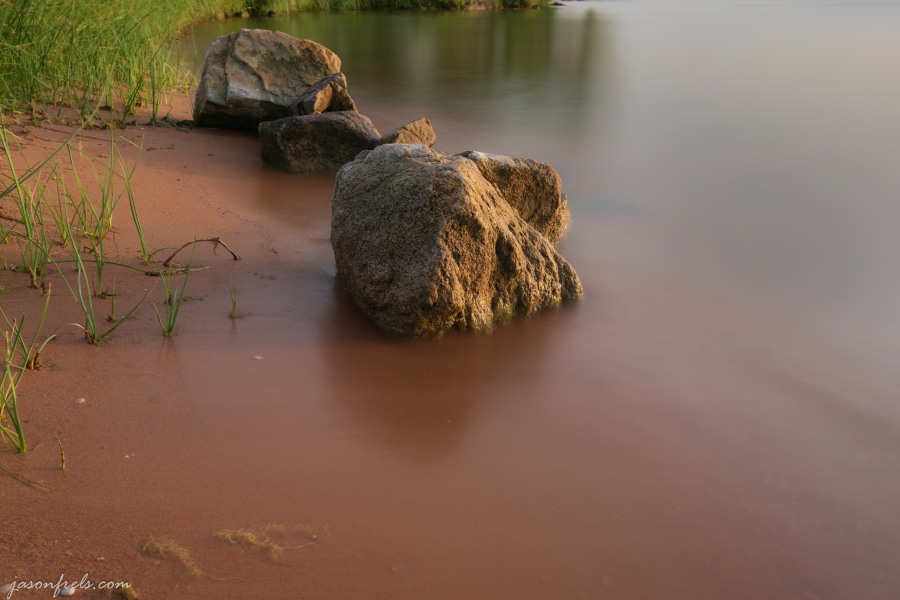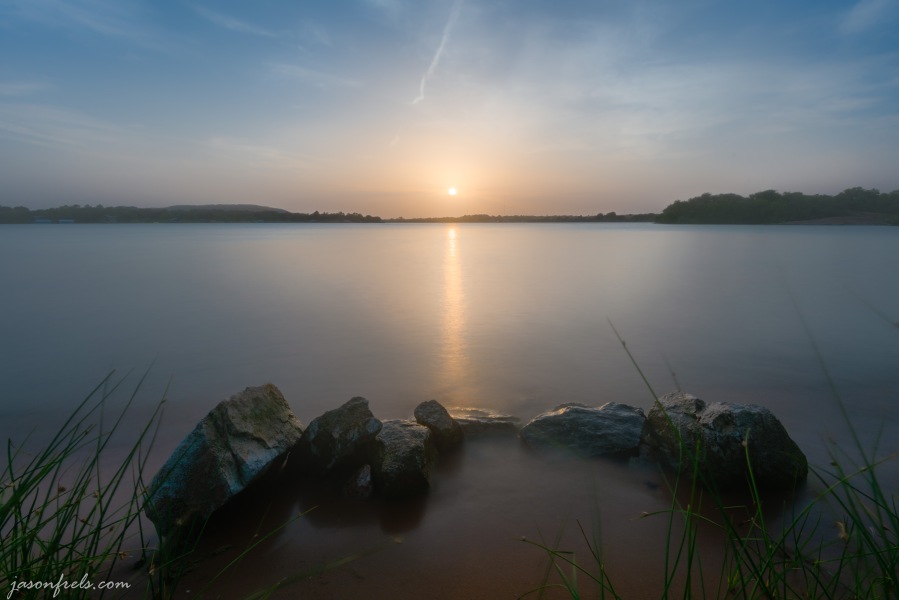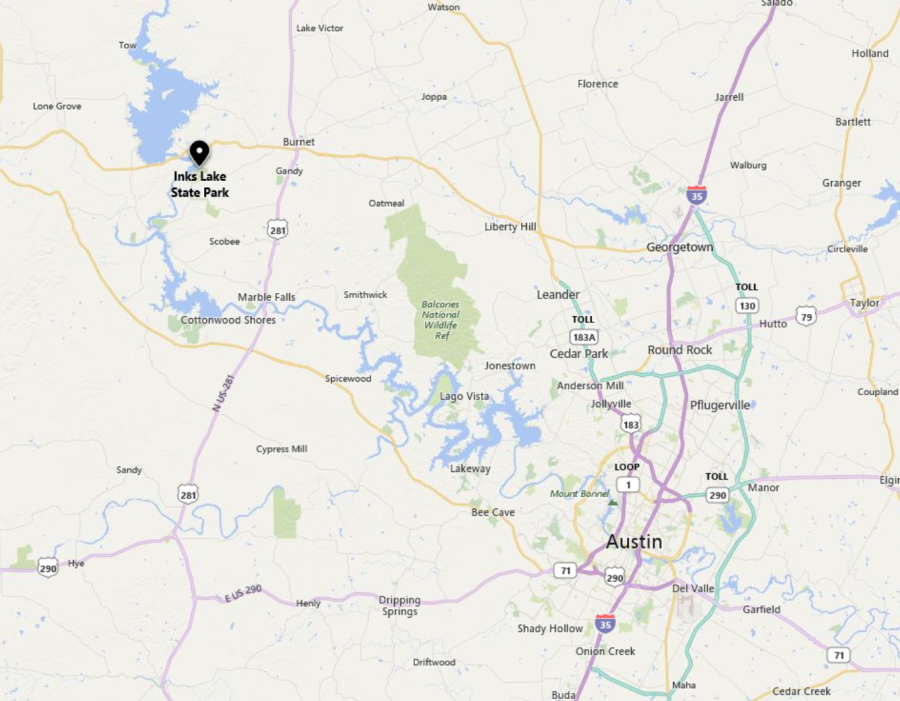I have been having fun with ND filters and long exposures recently and I realized that I have not done this at Inks Lake, which is one of my favorite places to be. I have a Texas State Parks pass so I can go there any time I want without paying additional money. On one particular evening the sky was shaping up to have nice late afternoon light, so I packed up my stuff and headed for Inks Lake State Park. My goal was to pick a particular spot and work only that spot to see how it develops and avoid running around chasing scenes.
Inks Lake is one of the reservoir lakes on the Colorado river to the Northwest of Austin. It is the smallest lake compared to the other nearby lakes, but it is a constant-level lake and there is a nice State Park there with hiking trails and campgrounds and I just love to be there. And, like nearly every other lake in Texas, Inks lake is artificial. Unlike Minnesota, the Land of Ten-Thousand Lakes, Texas would be the land of one or two lakes if not for the artificial ones.
I had a particular location in mind on the shore of the lake. I remember there being granite outcroppings in this spot and I thought I could find a nice foreground, get down really low and get the texture of the rocks with the lake and the setting sun in the background. When I arrived at this particular spot, I was immediately drawn to some small boulders sitting together at the edge of the lake. They were in some reddish sand and had some nice evening sunlight on them and so I began exploring different angles with these rocks.
In this first shot, I tried to get down close to the sand with the warm sunlight coming in from the side to give the rocks texture. I tried to avoid the grass as much as possible as I thought it would clutter up the picture. I also, went back and forth on horizon or no horizon. The background had a camper and boats in it and I thought that might be distracting. See both options below.


These were a couple of 20 second exposures using a 10-stop ND filter. There were actually some waves lapping at the rocks, but the long exposure smoothed that nicely. The sky in the second picture was really bright so I knocked it down a little in Lightroom. I really like the first picture, but it does seem to be missing something. The second picture with the horizon in the shot also has someone’s campground, which is OK as they are enjoying the lake like me and so it tells a bit of a story.
I then decided to get the other side of the boulders, so I kicked off my shoes and waded in a bit with my tripod in the water. There is a big tree behind these boulders and I wasn’t sure how that would photograph. There was enough wind to blur out some of the branches.

I don’t think that I got the light on the boulders that I was looking for with this photo. The stuff in the background behind the boulders is a bit distracting. I also think that the blurry branches don’t work.
Now for taking all of these photos I tried to go with a pre-planned checklist to get good photos. In the past, I think that I get excited and start shooting photos without taking time to set up correctly and I find that I have my ND filter on before I am really ready to shoot, which makes it really difficult to compose and focus. So, I made a note to myself before going out to follow these steps:
- Find a scene and imagine the composition that I want in my head
- Set up camera and compose the scene
- Select aperture and set focus
- Switch to manual focus to lock focus
- Disable vibration reduction on the lens as I am using a tripod
- Take a test exposure at ISO100 to get a shutter speed
- Leave focal length, focus, and ISO alone and install the ND filter
- Switch to manual mode, set the shutter to 1000 times the test exposure
- Enable remote shutter release
- Take photo and wait
Now I can recompose a bit by manually dialing the ISO up to 3200 – 6400 and dropping the shutter speed back down, taking some test photos, and dialing back the settings and shooting again. But it is much easier to just compose before you put on the ND filter.
As the sun neared the horizon I tried to find a way to include the setting sun in the photo with the boulders. The contrasted light was too much for a single photo so I tried something that I haven’t really tried before – an HDR with long-exposure photos. I was a bit concerned as it would take more than a minute to take the needed photos (20s, 10s, 5s, and 2.5s); each time is doubled for a noise reduction frame. I figured the payoff might be good as the boulders make a terrific foreground with the sun set on the horizon in the background. What I didn’t realize at the time because it was too bright, was that the setting sun would be reflected in a long line across the lake providing a beautiful leading line to the horizon.

This composition turned out much better than I had hoped. The boulders in the foreground form a nice group leading to the sun reflection line that leads to the sun setting on the horizon. The low sunlight really accentuates the textures of the boulders. The long exposure made the sun reflection really stand out against the gray-blue lake. There is some motion blur in the grass, but I really don’t mind as I really didn’t want the grass there to begin with. I processed this a couple of times in Photomatix Pro before I got the merge that I wanted; the challenge was not over-saturating the sun and clouds around it. There were a few blurry buoys in the water off to the right to mark the low wake zone and I removed them.
The horizon was very hazy, and you can’t tell from the photo but the sun was about to dip beneath some thick clouds leaving an unremarkable sunset. I went to another granite outcropping on the other side of the tree to try another concept, but more on that next time.
Thanks for reading and please leave a comment.


That sunset photo is really beautiful! It has a very calm mood to it.
LikeLiked by 1 person
Thanks. A 20 second exposure can kind of make things look calm.
LikeLiked by 1 person
[…] week when I wrote this blog, I was mainly focusing on some compositions that I did around a group of boulders in the lake at […]
LikeLike
[…] Long Exposures of Inks Lake, part 1 […]
LikeLike